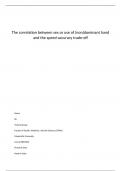Essay
GRADED GOOD: Fitts' law Scientific Writing project BBS1004
- Instelling
- Maastricht University (UM)
This is the final version of the Fitts' law project writing assignment. Highly praised by assessor. Contains strong introduction, clear m&m with explanation of used statistical analysis, good results with clear graphs and high quality conclusion/discussion. Complete with source list (14 sources). T...
[Meer zien]




